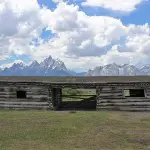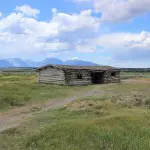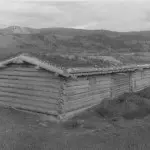John Pierce Cunningham was one of the first homesteaders in Jackson Hole, arriving in 1885 from New York. Reports vary, but most claim that he hunted and trapped for a few years before finding a wife and settling down in 1888. In 1888-1889 John and his wife Margaret built a modest cabin, which still stands today. By 1895, the cabin was used as a barn and as a blacksmith shop. In 1899, the Elk Post Office opened on their ranch, with Maggie Cunningham as the post master. A year later, the office moved to the Wolff Ranch. The Cunninghams lived in the early cabin while they had a larger house built to the northeast. The existing cabin is known as a “dog trot” or “double pen” construction. The saddle-v notched corners are of Appalachian origin. One of the earliest examples of homesteading architecture in the valley, the Cunningham cabin was strongly influenced by the style of log cabins typically seen in the east.
Cunningham owned or worked land near Flat Creek, it is unclear which but it was here in 1893 that he learned of a posse gathering to arrest two reported horse thieves at his ranch up north. He declined to take part, and waited to hear news of the events in town. Reports vary on the story, claiming that Cunningham had given the suspects, Mike Burnett and George Spencer, permission to use his ranch over the winter. Other say that they were squatting on the ranch, finding it empty. Some report that one of the men had come into town to brag about stealing horses and alerted suspicions. Others say that Cunningham went to check on the men after giving them permission to use his ranch and, noticing altered brands on the horses, raised the alarm himself.
Whatever the truth of the story, a posse did depart from Jackson intent on taking the thieves in. Making the situation more suspicious are two men who claimed to have been following the horse thieves through Montana and Idaho. They claimed to be lawmen, who gathered up men in town and “deputized” them in order to make things legal. This loosely organized posse rode up to the ranch at night to prevent scaring the horse thieves off. They expected it to be an easy capture. The next morning, they made their presence known but the two horse rustlers declined to surrender. When the thieves opened fire on the posse, they were outnumbered and killed in minutes. Their bodies were carried a short distance to the nearby creek and buried.
The locals decided to never talk of the incident again; they had become uneasy about the true identities of the two deputies who led the posse and worried that the two men at the Cunningham cabin were not horse thieves at all. When the posse had arrived on the ranch, there apparently were no horses to be found. Those involved reasoned that the thieves may have already taken the horses out of the valley, and returned to gather some items. It was possible though that rather than serving justice, the locals who had joined the posse had actually committed murder. Details of this incident, known commonly as the “Cunningham Ranch incident” were purposely confused and conflicting. No one wanted the true story told, and risk imprisonment or worse. The valley of Jackson Hole had come a long way in cleaning up their reputation from being known as a haven for bands of outlaws and thieves. No one wanted to tarnish the image the new community of Jackson was trying to portray. It is not known exactly where the two alleged thieves were buried. Reports of badgers digging up their bones serve to skew the true information of where they might actually been buried. Some oral and written evidence survives describing the location of the graves, but they contain conflicting information. After the Incident, Cunningham continued to live and work on his ranch, undeterred by the violence that had taken place. In his later years, he proved to be the only “old-timer” who would even speak about the event. But whether his stories were based on fact or fiction is still not known. He may have intended to keep the fictional elements alive when people began digging into history and rediscovered the Incident at the Cunningham Ranch.
In 1909 Cunningham sold his ranch to J.P. Nelson, who owned the Jackson Hotel. Earlier this year, Cunningham had been granted a second patent for his land under the Desert Land Act of 1877. He used 140 of these additional 160 acres for raising hay, the remaining 20 were for his cattle. Cunningham and Nelson agreed to a swap, with Nelson turning to ranching and Cunningham turning to town life. In town, the Nelsons had owned the Jackson Hotel. After only a few years, Cunningham missed his ranch and Nelson agreed to sell it back, purchasing his own 160 acres just to the south. In 1914 when Cunningham moved back to his ranch, he also acquired the Bar Flying U brand, along with the lands and cattle from the nearby Uhl ranch. Cunningham’s original brand, a connected JP, was too similar to the one that J.P. Nelson had used, JPN, in his absence. Now that Nelson was living so nearby, Cunningham wanted to make sure they could tell their cattle apart. Cunningham purchased the nearby Uhl ranch and continued to use their brand to keep things orderly. The Cunningham Ranch was now known as the Bar Flying U Ranch.
Cunningham, with Struthers Burt and neighbor Josiah Ferrin, was one of the biggest proponents in the valley for keeping the land protected. In 1927, Cunningham, Burt and Ferrin wrote and distributed a petition describing the need for a federal entity to assume management of the valley. Drought and falling beef prices after World War I had ravaged crops in the valley. Cunningham in particular was hit hard by the drought. They argued that the best use for the remaining open lands in the valley was for “recreation,” and they persuaded 97 of their neighbors to sign the petition. The idea was to relieve the pressure of taxes but still run a profit from ranching. The ranchers could sell their lands with a lease, allowing them to continue ranching operations without being financially responsible for the land. If continued ranching proved to be too difficult, they could simply walk away.
Many who signed the petition had previously against a National Park extension, or anything relating to the federal government taking the lands back. While all this happened decades before Grand Teton National Park would appear as it does today, the petition caught the attention of the men who were working to create the Snake River Land Company, secretly backed by John D. Rockefeller, Jr. This separate operation had been forming since Rockefeller’s first visit to the valley in 1926. The Company formed officially in 1927 and began approaching homesteaders with offers to purchase their lands. Their intention in keeping Rockefeller’s name hidden was to prevent land appraisals from skyrocketing.
Cunningham wanted to prove his commitment to protecting the valley; he was one of the first to sell his ranch in 1928. He was also one of very few valley residents who understood what the eventual plans would be for his homestead. In 1930, Rockefeller announced his involvement with the Snake River Land Company due to rampant rumors that the Company was purchasing exhausted homesteads to sell at a profit. This was the exact situation the 97 residents who signed the petition was afraid of. Rather than receiving support for “saving” the lands of Jackson Hole, Rockefeller was reviled. The valley residents had worked hard on their ranches, and felt that this was another example of the federal government stepping in to take their rights as landowners away. Had Rockefeller been open about his intentions from the start, he likely would have been supported.
After the sale of his ranch, Cunningham left Jackson Hole and settled in Victor, Idaho. In 1943, his ranch would be part of the Jackson Hole National Monument, made up of lands purchased by Rockefeller. Seven years later in 1950, after much political turmoil, the Rockefeller lands would be incorporated into the expansion of Grand Teton National Park. Today only the original cabin remains on the property, the barn, shed, corrals and large ranch home were all taken down. The Cunningham cabin is the oldest homesteading-era structure left in the park, a reminder of the turbulent days of early settlement in the valley.
TIMELINE
1885: John Pierce Cunningham arrives in Jackson Hole, hearing about the success of other trappers. He remains in the valley for three years before he marries his wife, Margaret, and the two settle on a piece of land south of Spread Creek.
1889: Cunningham builds a modest cabin that was later converted to use as a barn.
1893: Mike Burnett and George Spencer, reported horse thieves are killed at the Cunningham cabin. The shooting would later become known only as the “incident at the Cunningham ranch.”
1899: The Elk Post Office opens on the Cunningham Ranch, with Maggie Cunningham as the post master that year. The next year it transferred to the Wolff family.
1900-4: Cunningham continues to make improvements on his land, adding a large ranch house, barn, shed and corrals. By this time, Cunningham had cultivated 100 acres of land for his growing cattle operation.
1906: Cunningham receives his patent for 160 acres.
1909: Cunningham sells his ranch to the Nelsons, and adds 160 additional acres under the Desert Land Act of 1877. In return for this ranch, J.P. Nelson gives Cunningham the Jackson Hotel. The two families swap lives, trading ranching for town living.
1914-15: Cunningham purchases his ranch back from Nelson, also acquiring the nearby Uhl ranch land and brand, the Bar Flying U. The Nelsons purchase a homestead just to the south of the Cunningham ranch. Jack Eynon takes over hotel management from the Cunninghams.
1927: Cunningham, along with neighbors Josiah Ferrin and Struthers Burt, circulate a petition throughout the valley calling for federal protection of their lands. Ninety-seven neighbors sign the document, many previously opposed to selling their land back to the federal government. Later this year, the Snake River Land Company forms with John D. Rockefeller Jr. as the secret backer.
1928: Cunningham becomes one of the first to sell his ranch to the Snake River Land Company. He departs the valley and settles in Victor, Idaho.
1943: The Cunningham ranch becomes part of the Jackson Hole National Monument. All buildings except for the original ranch cabin are removed.
1950: The Cunningham cabin becomes part of Grand Teton National Park. Today, it is the oldest structure in the park.
Text by Samantha Ford, Director of Historical Research and Outreach


